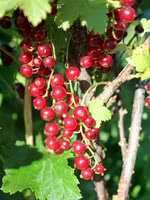Mon-Fri 9am - 5pm Mountain time
Red Currant vs Common Blueberry
Ribes rubrum
Vaccinium myrtilloides
NOT AVAILABLE THIS SEASON - MIGHT RETURN
NOT AVAILABLE THIS SEASON - MIGHT RETURN
Red Currant is a deciduous shrub native to western Europe. It features five-lobed, maple-like leaves, and bright red berries that can be used in jams, sauces, and fresh eating.
Although this shrub is self-fertile, it will be more productive if another pollinator is present. For year over year high yields, ensure you fertilize (bone meal), prune, and mulch your Red Currant shrub.
Common Blueberry is an August maturing berry that is wonderfully flavorful and contain more antioxidants by volume than the highbush varieties.
They'll give your baked goods a wonderful pop of flavor.
It isn't as large, pretty, or high yielding as the other varieties we carry. But Common Blueberry is one of the only blueberries that will survive in plant hardiness zones 1A to 2B.
Note: Blueberries require very specific soil conditions. They need well-drained soil with a pH between 4.5 and 5.0.

